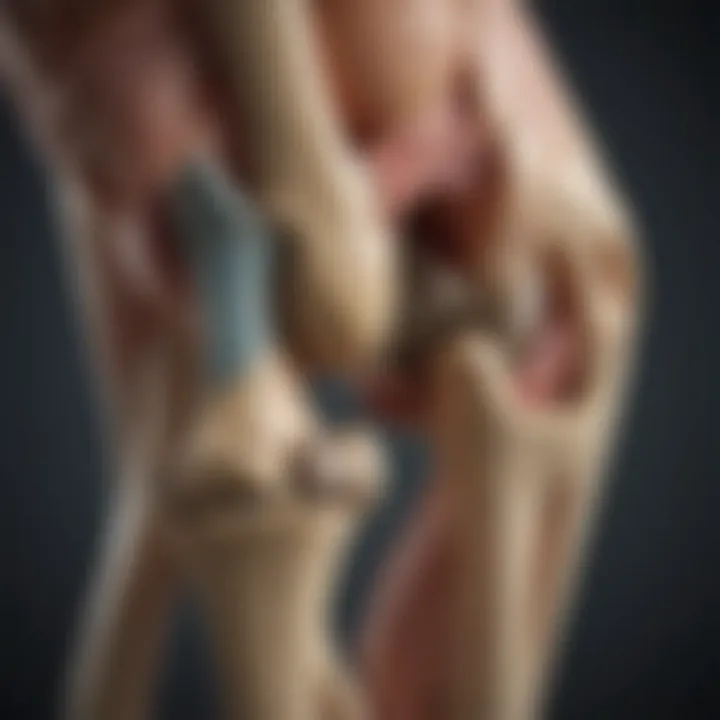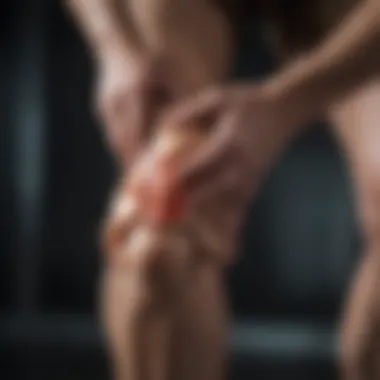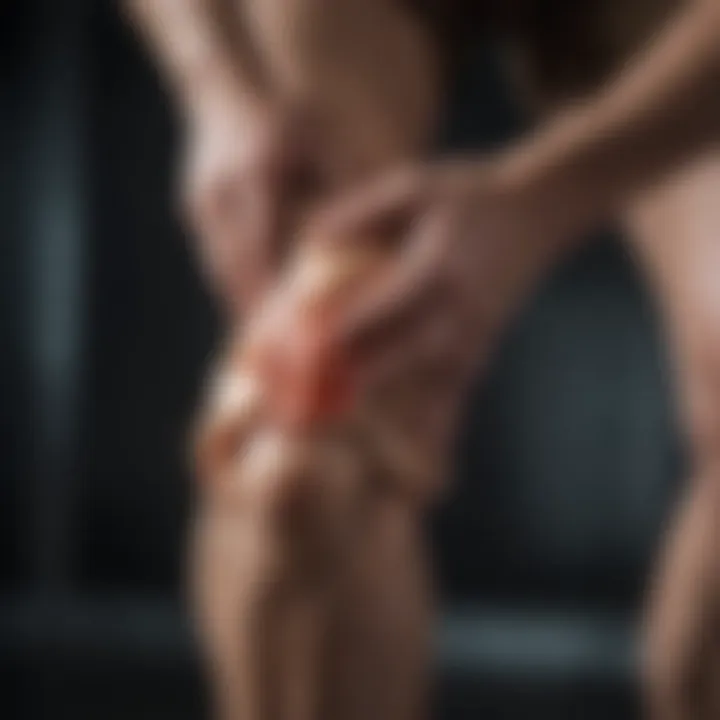Exploring the Intricacies of Knee Pain Management


Intro
Knee pain affects a significant number of individuals worldwide, transcending age and activity level. Whether it’s a twinge after a long run or persistent throbbing during daily activities, understanding the nuances of knee pain can shed light on potential treatments and preventative measures. The knee, being a complex joint, is susceptible to various forces that can lead to discomfort and dysfunction.
Knee pain doesn’t just stem from injuries; it can also arise from underlying health conditions, which adds another layer of complexity. By breaking down the key concepts surrounding knee pain, including its anatomy, common causes, and effective treatments, we can better equip ourselves to manage it and improve our quality of life. This analysis will serve as a vital resource, particularly for students and professionals eager to dissect the anatomy of knee pain and its repercussions on everyday mobility.
Key Concepts
Definition of Primary Terms
To enlighten our understanding, it’s crucial to define some terms that are often thrown around in discussions of knee pain:
- Knee Joint: This is the hinge that connects the thigh bone (femur) with the shin bone (tibia), allowing for movement while providing stability.
- Cartilage: A connective tissue that cushions the knee joint and aids in smooth motion.
- Ligaments: Tough bands of tissue that connect bones and provide support, known in the knee as the anterior cruciate ligament (ACL) and posterior cruciate ligament (PCL).
- Tendons: The link between muscles and bones, facilitating movement.
Related Concepts and Theories
Several theories aim to explain why knee pain occurs and offer insights into potential solutions:
- Osteoarthritis: A degenerative joint disease that often leads to the thickening of the cartilage and bone spurs, causing chronic pain.
- Biomechanical Factors: How body alignment and movement patterns contribute significantly to knee stress and pain.
- Inflammation: A natural response to injury, but when persistent, it can exacerbate pain conditions in the knee.
Understanding these terms and concepts sets the stage for a deeper exploration of the various aspects of knee pain.
Future Directions
Gaps Identified in Current Research
Despite advancements in healthcare, there remain significant gaps in understanding knee pain, particularly the variance in individual responses to treatment. Current studies often focus on major injuries but may overlook subtler, chronic conditions that impact numerous individuals on a daily basis.
Suggestions for Further Studies
Future research might benefit from focusing on the following areas:
- Investigating the influence of lifestyle choices on the onset of knee pain, such as diet and physical activity.
- Analyzing the effectiveness of alternative therapies like acupuncture or specific forms of physical therapy.
- Exploring age-related changes in knee joint function and how they correlate with pain severity.
Keeping these aspects in mind will guide us to a more nuanced understanding of knee pain and its far-reaching effects.
Preface to Knee Pain
Understanding knee pain is paramount not only for those who suffer from it but also for medical professionals, educators, and students keen on comprehending the complexities around this common ailment. According to recent studies, knee pain affects nearly one in four adults at some point in their life, making it a significant public health concern. This section aims to illuminate the importance of grasping the nuances of knee pain, its anatomy, and the conditions that lead to discomfort, thereby laying a foundation for readers to appreciate the subsequent treatments and preventive measures that can enhance quality of life.
The Importance of Understanding Knee Pain
Knee pain is not merely a symptom but a complex experience that can stem from various causes, such as injuries, arthritis, and overuse. Recognizing the underlying reasons for knee pain empowers individuals to seek proper care and engage in effective rehabilitation practices. Moreover, having a thorough understanding of knee mechanics can help prevent further injuries. With an array of causes ranging from acute injuries to chronic conditions, increased awareness leads to better self-management and proactive care strategies.
Overview of Knee Anatomy
A foundational grasp of knee anatomy can demystify many of the conditions that lead to pain and dysfunction. The knee is a dynamic joint composed of several key structures, each playing a pivotal role in its overall function. Understanding these components enhances one’s insight into how different injuries and illnesses can affect mobility and daily activities.
Bone Structures
The knee primarily consists of three bones: the femur (thigh bone), tibia (shin bone), and patella (kneecap). The interaction and alignment of these bones are crucial for stability and movement. Notably, the femur and tibia form the central joint, supported by the patella at the front, which serves as a protective shield. The sturdy structure of these bones withstands the pressures from walking, running, or jumping, which underscores their significance in maintaining proper knee function. However, when injuries occur, such as fractures or dislocations, the bones can be severely affected, leading to debilitating pain and reduced mobility.
Cartilage Composition
Cartilage, a rubbery tissue that cushions the ends of bones, is essential in allowing smooth joint movement. In the knee, there are two main types of cartilage: articular cartilage, which coats the ends of the femur, tibia, and patella, and the menisci, two C-shaped cartilages that act as shock absorbers. The unique composition of cartilage makes it resilient yet offers limited capacity for healing when damaged. Consequently, understanding cartilage's role is key since joint issues often arise from its wear and tear, increasing the likelihood of osteoarthritis.
Ligaments and Tendons
Ligaments, which connect bone to bone, and tendons, that link muscle to bone, are crucial for knee stability. The knee has four primary ligaments: anterior cruciate ligament (ACL), posterior cruciate ligament (PCL), medial collateral ligament (MCL), and lateral collateral ligament (LCL). Each has a specific role in maintaining joint integrity during movement. For instance, while the ACL helps prevent forward sliding of the tibia, the MCL safeguards against sideways forces. Tendons, particularly the quadriceps and patellar tendons, facilitate proper movement. A nuanced comprehension of ligaments and tendons can provide insight into common injuries such as sprains and strains, which often lead to knee pain.
Understanding the interactions between these structures is critical for diagnosing pain and establishing effective treatment options.
Types of Knee Pain
Understanding the different types of knee pain is crucial for several reasons. First off, it helps in accurately identifying the underlying issue affecting the knee. Knowing whether the pain is acute or chronic, localized, or radiating can steer both patients and healthcare professionals towards the right treatment and management strategies. Moreover, it can significantly influence the rehabilitation process. Differentiating between types can also aid in developing preventive measures, allowing individuals to make informed choices about their activities and lifestyles.
Acute vs. Chronic Knee Pain
Acute knee pain typically sets in suddenly, often as a result of a specific injury or trauma, such as an ACL tear or a fall. Characterized by intense, sharp, and sudden sensations, this type of pain can limit movement and often requires immediate medical attention. On the flip side, chronic knee pain develops gradually over time, usually due to age, wear-and-tear conditions like osteoarthritis, or other degenerative issues. This type tends to be more insidious, manifesting as a persistent dull ache that can sometimes flare up based on activity levels.
Both types of pain carry distinct implications for treatment. Someone experiencing acute pain might find themselves in the emergency room, while chronic pain often requires a series of appointments with specialists. Thus, understanding these differences lays the foundation for any further examination of knee discomfort.
Localized Knee Pain
Localized knee pain refers to pain that is confined to specific areas of the knee. This can dramatically influence a person’s mobility and quality of life.
Pain Specific to the Patella
Pain specific to the patella, commonly known as patellofemoral pain syndrome, often arises due to overuse, misalignment, or injury. Patients frequently describe it as a deep-seated ache that worsens with activities like squatting or going up and down stairs. The key characteristic of pain around the patella is its ~biomechanical sensitivity~. Uneven force distribution during movement can lead to discomfort, particularly in active individuals. The unique aspect here is how common this syndrome is among athletes, suggesting that while it’s prevalent, it can often be successfully managed with targeted physical therapy and proper rest.
- Advantages: Early intervention through physical therapy can prevent more severe issues.
- Disadvantages: Failing to address this problem may result in persistent pain or chronic conditions.
Pain Around the Joint
Pain around the joint encompasses a broader range and can be indicative of myriad issues, from inflammation to advanced arthritis. The sensation often blankets the knee itself, making it harder to pinpoint. What sets this type apart is its potential relation to both acute injuries and chronic degenerative problems.
This pain is generally felt during activities that involve bending or twisting the knee, such as walking or running. Moreover, it might indicate underlying conditions like bursitis or osteoarthritis. The primary strength here is its ability to alert individuals to both simple and complex issues, bringing attention to deeper problems if managed correctly.


- Advantages: Identifying specific patterns can guide appropriate therapeutic exercises.
- Disadvantages: The nonspecific nature can sometimes lead to misdiagnoses, complicating treatment plans.
Radiating Knee Pain
Radiating knee pain is a different kettle of fish altogether. It usually feels like discomfort that spreads from other areas, often from the hip or lower back.
Referred Pain From Hip or Back
Referred pain often confuses many individuals, as it originates from different parts of the body but manifests in the knee. For example, issues such as a herniated disc may cause radiating discomfort down to the knee. This pain can feel sharp or dull, and sometimes, it may even be mistaken as localized knee pain. The significance of recognizing referred pain lies in its unique etiology, empowering clinicians to treat the root cause rather than just the symptom.
- Advantages: Proper recognition allows for a more holistic treatment approach.
- Disadvantages: Patients may struggle to connect their back or hip issues with knee pain, delaying treatment.
Symptoms of Neuropathy
The symptoms of neuropathy could range from tingling, burning sensations, to complete numbness around the knee. Neuropathy usually derives from conditions such as diabetes or multiple sclerosis. These symptoms serve as a major red flag, often pointing towards systemic issues that require urgent medical intervention. What sets neuropathic symptoms apart is their potentially complex nature, where mere knee pain is just the tip of the iceberg.
- Advantages: Early identification can lead to more effective management of underlying conditions.
- Disadvantages: Patients often misinterpret neuropathic pain as regular discomfort, leading to ineffective self-treatment.
Common Causes of Knee Pain
Understanding the common causes of knee pain is essential for anyone grappling with discomfort in this crucial joint. This section will delve into various aspects that contribute to knee pain. Identifying the root cause helps in charting an effective treatment plan. From injuries to degenerative conditions, each cause offers distinct challenges and implications for mobility and quality of life.
Injuries
ACL Tears
Anterior cruciate ligament (ACL) tears are a leading cause of knee pain, particularly among athletes. This injury typically occurs during activities that involve sudden stops or changes in direction. The unique characteristic of ACL tears is that they can lead to instability in the knee joint, making it challenging to participate in physical activities without fear of further injury. This condition is a focal point in knee pain discussions because of its prevalence in sports. One disadvantage, however, is that recovery from an ACL tear often requires surgical intervention and extensive rehabilitation, which can be a lengthy and challenging process.
Meniscus Injuries
Meniscus injuries occur when the cartilage that cushions the knee joint is torn, often from twisting motions or heavy lifting. The presence of a meniscus tear can produce pain, swelling, and a sensation of locking in the knee. This condition is significant in our analysis as it can affect individuals of all ages, particularly those who engage in sports or strenuous activities. A notable feature of meniscus injuries is their potential for developing into chronic knee problems if not treated properly. The primary setback is that the healing process can be prolonged due to the limited blood supply to the meniscal tissue, making it slower to recover.
Tendinitis Factors
Tendinitis in the knee is often the result of repetitive stress on the knee tendons, particularly in athletes or individuals with active occupations. It can result in significant pain and discomfort during movement. The highlighted aspect of tendinitis is its gradual onset, making it easy to overlook until it significantly hampers mobility. This topic is relevant here because managing tendinitis effectively can prevent further deterioration and aid in rehabilitation. However, one downside is that if not addressed promptly, tendinitis can lead to more severe complications such as tendon tears.
Arthritis and Degenerative Conditions
Osteoarthritis
Osteoarthritis is characterized by the degradation of cartilage and can affect any joint, with the knee being particularly vulnerable. This condition is a common source of knee pain, particularly in older adults. The hallmark of osteoarthritis is its gradual onset, often accompanied by stiffness and swelling. This topic is relevant in discussions of knee pain as it significantly impacts mobility and quality of life. An important feature of osteoarthritis is the potential for pain to be managed through lifestyle changes and various treatments. However, a downside is that it is a progressive condition, which means that without monitoring and intervention, symptoms can worsen over time.
Rheumatoid Arthritis
Rheumatoid arthritis is an autoimmune condition that leads to chronic inflammation in the joints, including the knee. This condition not only causes pain but can also lead to joint deformity if not managed correctly. The key characteristic here is that rheumatoid arthritis impacts people of any age, making it an important consideration in our evaluation of knee pain. Its relevance lies in the potential for significant, long-term joint damage if left untreated. One notable challenge is that the pain and swelling can fluctuate, complicating diagnosis and treatment plans.
Post-traumatic Arthritis
Post-traumatic arthritis can develop after a knee injury, such as fractures or ligament damage. This condition can emerge years after the initial injury, making it tricky for individuals to associate the pain with past trauma. The highlight of post-traumatic arthritis is its connection to previous knee injuries, which becomes crucial in understanding the progression of knee pain. The advantage here is that recognizing the condition early can lead to more effective management strategies. On the other hand, the downside is that it often results in chronic pain and may necessitate more invasive treatments eventually.
Other Medical Conditions
Bursitis
Bursitis is the inflammation of the small sacs of fluid (bursae) that cushion the knee joint. This condition can result from overuse or infection and can produce significant pain and swelling. The distinct feature of bursitis is that while it's often temporary, it can significantly affect day-to-day activities. Understanding this condition is beneficial because many treatments are available, from rest to corticosteroid injections. The downside is that if left untreated, bursitis can become chronic and lead to persistent pain.
Gout
Gout is a type of arthritis caused by the accumulation of uric acid crystals in the joints, particularly the knee. This condition often manifests suddenly and can cause severe pain and inflammation. The unique aspect of gout is that it can be tied to dietary habits, making it an important topic in the context of treatment and prevention. Its relevance is heightened due to its tendency to recur, which can greatly diminish a person's quality of life. However, managing gout often involves medications and lifestyle changes that can be invasive and challenging for individuals.
Chondromalacia Patella
Chondromalacia patella, or "runner's knee," involves the softening and breakdown of the cartilage on the underside of the kneecap. This condition is frequently seen in athletes and can lead to pain during movement. Its significance lies in its prevalence among active individuals, making it crucial for understanding knee pain sources. The advantage of recognizing this condition early is that it can often be addressed with physical therapy and activity modifications. Still, untreated chondromalacia can progress and potentially require surgery, adding to recovery challenges.
Evaluating Knee Pain
Evaluating knee pain is a fundamental part of understanding its underlying causes. A thorough assessment not only helps pinpoint the origin of discomfort but also plays a crucial role in crafting effective treatment plans. Knowing the specifics of how a knee feels—whether there’s swelling, limited movement, or tenderness—guides healthcare professionals in making informed decisions. It’s like detective work, where each detail paints a clearer picture of what’s going on inside that often-overlooked joint. After all, the knee bears the brunt of our daily activities, and its health directly impacts mobility and overall life quality.
Physical Examination Techniques
Range of Motion Assessments
Range of motion assessments stand out as a key element in evaluating knee pain. These assessments provide direct insight into the knee's functional capabilities. By measuring how far a patient can bend or straighten their knee, healthcare providers can identify any restrictions or unusual stiffness. The versatility of this technique makes it a widely used tool. It’s popular because it’s straightforward and effective for both the patient and the clinician.
One unique feature of range of motion assessments is that they can be conducted in various positions—sitting, standing, or lying down—accommodating patients with different physical abilities. Their main advantage lies in their simplicity and the immediate data they yield. However, they do have limitations; for instance, range of motion assessments alone may not reveal underlying issues such as tears or fractures.
Palpation Techniques
Palpation techniques focus on feeling the knee to gather information. This method allows practitioners to identify tender areas, swelling, or fluid accumulation. The key component of palpation is its tactile nature—it’s very personal and can often yield more reliable results than just asking questions. It’s considered beneficial because it engages the clinician’s hands as a tool for diagnosis, lending an extra layer of insight.
Palpation’s unique feature is its immediacy; a clinician can often sense problems just beneath the surface. For instance, if there’s inflammation, the knee will feel warmer or more swollen to the touch. The downside of this technique is its subjective nature; different practitioners might feel things differently, which can lead to varied interpretations.
Diagnostic Imaging Methods
X-Rays
X-rays serve as a staple in diagnosing knee pain. Their capacity to provide a clear view of bone structure makes them invaluable. They can reveal fractures, dislocations, and even signs of arthritis by showing joint space narrowing. The key characteristic that makes X-rays popular is their accessibility and speed in imaging techniques.
What sets X-rays apart is their ability to detect changes in bone density and structure without the need for invasive procedures. They provide a solid first step in understanding knee issues, although they typically do not capture soft tissue injuries. The primary disadvantage comes from their inability to reveal cartilage damage or ligament conditions, which may necessitate further imaging for a comprehensive evaluation.


MRIs
Magnetic Resonance Imaging (MRI) strengthens the diagnostic toolkit, especially concerning soft tissues. They’re particularly adept at visualizing ligaments, tendons, and menisci, which provides a broader picture of knee health. The unique feature of MRIs is their ability to produce high-resolution images through non-invasive magnetic fields. This makes it a beneficial choice for those with concerns beyond mere fractures.
The downside? MRIs can be pricey and time-consuming, not to mention that some patients may experience anxiety or discomfort while in the machine. Despite these drawbacks, their precision and depth of detail make them a gold standard in imaging when assessing knee pain.
Ultrasound
Ultrasound imaging has emerged as an innovative alternative for evaluating knee conditions. Its real-time imaging capability allows for dynamic assessment, making it possible to observe the knee while it’s in motion. A key characteristic of ultrasound is its portability and ease of use, making it suitable for bedside assessments or in physical therapy settings.
One of the standout features of ultrasound is its ability to assess blood flow in real time and visualize soft tissues without radiation exposure. However, it does have limitations. It’s operator-dependent, meaning the skill and experience of the technician can significantly affect the results. Also, it may not be the best choice for chronic conditions that require a detailed structural study, as MRIs might provide more insights.
Treatment Options for Knee Pain
Understanding treatment options for knee pain is crucial as it not only addresses the immediate discomfort but also contributes to long-term health and mobility. The approach to therapy can vary widely based on the underlying causes and individual needs. It’s a balancing act between managing pain effectively and maintaining or restoring functionality. By exploring these options, patients can gain insight into what might work best for them, ensuring that they lead a more active and pain-free lifestyle.
Conservative Management Strategies
Physical Therapy
Physical therapy plays a significant role in rehabilitating knee pain. The essence of this treatment is its tailored programs that cater to the individual needs of patients. A key characteristic of physical therapy is its focus on rehabilitation through exercises and hands-on techniques that not only relieve pain but also improve mobility and strength over time. Physical therapy is a beneficial choice because it enhances functional abilities and empowers individuals by teaching them how to manage their condition effectively.
One unique feature of physical therapy is its interdisciplinary approach. For instance, the therapist may collaborate with physicians and dietitians to create a comprehensive treatment plan. The advantages include reduced dependence on medications and a lower risk of surgery. However, access to qualified therapists can be a challenge for some, and it requires commitment and regular attendance to sessions to see results.
Medications
Medications offer a quick way to relieve pain and inflammation associated with various knee conditions. Commonly prescribed options include nonsteroidal anti-inflammatory drugs (NSAIDs) like ibuprofen or naproxen, which are effective in alleviating pain. A key characteristic of medications is their immediate impact on symptoms, making them a popular choice among patients seeking relief from discomfort.
The unique feature of medications lies in their convenience—taking a pill or using topical solutions can be done at home without any special training. Though they provide substantial relief, the disadvantages can’t be overlooked. Long-term use may lead to side effects like digestive problems or dependency. Therefore, medications are often recommended in conjunction with other treatments to optimize benefits while minimizing risks.
Rest and Ice Application
Rest and ice application is one of the simplest yet most effective methods to manage knee pain, especially after an injury or strain. The key characteristic of using rest is its role in allowing the damaged tissues to heal without further stress. Ice application provides immediate relief by reducing swelling and numbness in the affected area. For many, this approach is a beneficial first step in their pain management journey.
What makes the use of rest and ice particularly appealing is its accessibility—anyone can do it at home, and it requires no special equipment. However, relying solely on these methods without a comprehensive treatment strategy could lead to prolonged recovery.
Surgical Interventions
When conservative management fails, surgical interventions may become necessary. These procedures aim to restore function and alleviate pain caused by structural issues within the knee. Understanding these options is vital for those considering surgery.
Arthroscopy Procedures
Arthroscopy is a minimally invasive surgical approach that allows doctors to examine the knee’s interior through small incisions. This technique is advantageous because it generally results in less pain, quicker recovery times, and minimal scarring. An important characteristic of arthroscopy is its ability to provide a direct view of the knee's condition, all while allowing for certain repairs, such as removing loose cartilage or repairing torn ligaments.
As a result, arthroscopy is a highly beneficial option for individuals seeking a less disruptive surgical remedy. However, risks like infection or complications from anesthesia can occur, and recovery can still require significant rehabilitation.
Joint Replacement Surgeries
In more severe cases of knee damage, joint replacement surgeries may be necessary. These surgeries involve replacing damaged cartilage and bone with prosthetic components, completely transforming the knee's structure. A key characteristic of joint replacement surgeries is their ability to provide significant pain relief and improved mobility for patients who have exhausted other options.
A unique aspect of this surgery is its long-lasting effects, with many individuals enjoying a better quality of life for years post-operation. Nevertheless, it also comes with extensive recovery time, and like any major surgery, carries risks, including blood clots and complications specific to the procedure.
In summary, a well-rounded treatment plan, whether conservative or surgical, can significantly enhance outcomes for those suffering from knee pain. By understanding the spectrum of options available, patients can navigate their choices with more confidence.
Rehabilitation and Recovery
Rehabilitation and recovery play critical roles in the journey toward overcoming knee pain, especially after surgical interventions. Following a procedure, it’s not merely about resting and waiting for the pain to fade. A comprehensive rehabilitation strategy not only facilitates healing but also helps in regaining strength and mobility. Understanding this topic provides insights into effective practices that can greatly enhance the recovery experience, ensuring that individuals return to their daily activities as swiftly and safely as possible.
Post-Surgery Rehabilitation
Rehabilitation Protocols
Rehabilitation protocols outline the step-by-step procedures followed after surgery to ensure proper healing of the knee. These protocols are designed by rehabilitation specialists and often vary based on the specific type of surgery performed. A key characteristic of these protocols is their ability to be customized to the individual, addressing unique needs and goals. This personalized approach is particularly beneficial as it considers factors such as age, activity level, and overall health.
The unique feature of rehabilitation protocols is their phased structure. In the initial phase, focus is usually on reducing swelling and managing pain. Gradually, as healing progresses, the emphasis shifts to restoring range of motion before finally introducing strengthening exercises. The advantages of such protocols include reduced risk of re-injury and improved functional outcomes, though they can be demanding, requiring a commitment that some individuals may find challenging.
Goals of Rehabilitation
The goals of rehabilitation post-surgery are centered on restoring knee functionality, alleviating pain, and promoting a full recovery. One key characteristic here is the establishment of both short-term and long-term objectives. For instance, short-term goals might focus on reducing pain and swelling, while long-term goals could include returning to pre-surgery activity levels.
A unique feature of setting these goals rests in their measurable nature; progress can be tracked through specific milestones such as improved range of motion, decreased pain levels, or increased strength. Setting realistic and achievable goals is advantageous as it helps maintain motivation throughout the recovery process, although being overly ambitious can lead to frustration if progress stalls or setbacks occur.
Self-Management Techniques
Self-management techniques empower individuals in their recovery journey by providing them with tools and exercises they can manage independently. This approach fosters a sense of agency, making patients active participants in their healing process.
Strengthening Exercises
Strengthening exercises are vital in integrating muscle support around the knee joint, crucial for enhancing stability and functionality. A key characteristic of these exercises is that they may vary in intensity and form, allowing adaptations based on progress and pain levels. Some exercises focus on the quadriceps while others engage the hamstrings or calves. This beneficial aspect ensures a balanced approach to strengthening.
An advantage of incorporating these exercises early on is their potential to expedite recovery. However, they need to be approached cautiously; engaging in activities too soon or with incorrect form can lead to further complications.
Flexibility Workouts
Flexibility workouts are designed to improve the range of motion in the knee, which can become limited due to pain or surgery. The key characteristic of flexibility training is its focus on gentle stretching techniques that enhance joint mobility without causing undue discomfort. Such workouts may include static stretching and gentle movements that promote blood flow to the muscles around the knee.
The unique feature here is how these workouts can easily integrate into a daily routine, requiring minimal equipment and space. The advantages of maintaining flexibility include not only improved mobility but also reduced stiffness, making everyday activities—like walking or climbing stairs—easier and more comfortable. Still, caution should be exercised to avoid overstretching, which could cause injury.
"Recovery is a journey, not a race. Paying attention to the body's signals is paramount in rehabilitation."


In summary, grasping the nuances of rehabilitation and recovery after knee surgery equips individuals with a roadmap to regain their pre-injury capabilities, thus enhancing their quality of life. Understanding rehabilitation protocols and setting realistic goals, while employing self-management techniques like strengthening and flexibility workouts, will lead to informed choices that shape recovery outcomes.
Preventive Measures for Knee Health
Preventive measures for knee health are crucial, as they help maintain optimal function and prevent the occurrence of pain or injury. Knee pain can limit mobility and adversely impact quality of life. By taking preventative steps, individuals can not only reduce their risk but also enhance their overall well-being.
Adopting preventive practices allows for better knee resilience and can ward off several issues before they escalate into more significant health concerns.
Lifestyle Changes
Weight Management
Weight management plays a pivotal role in maintaining knee health. Excess weight puts added strain on the knee joints. This additional stress can lead to wear-and-tear conditions such as osteoarthritis. Maintaining a healthy weight helps distribute body weight evenly, easing the strain on the knees during physical activities.
One key characteristic of weight management is its dual approach: it involves both dietary choices and physical activity. Dieting alone can yield results, but when paired with exercise, individuals often find success more sustainable.
Unique to this practice is the gradual and consistent approach to losing weight. Instead of extreme diets, individuals benefit from small, manageable changes that can be maintained long term. The advantage here is a lower likelihood of rebound weight gain, which often follows more drastic measures.
Exercise Regimens
Exercise regimens are vital for knee health as they strengthen the muscles surrounding the knee, providing better support and stability. Engaging in regular, low-impact exercises, like swimming or cycling, is particularly beneficial. These activities minimize joint stress while enhancing muscle strength.
The key aspect of exercise regimens is their adaptability. Whatever your fitness level, there are suitable exercises for everyone. This inclusivity makes it a favored choice for maintaining knee health.
One standout feature of exercise is flexibility. It combines strengthening routines with stretching, which increases range of motion and can reduce the risk of injuries. The main disadvantage is the potential for overexertion. So, it’s imperative to start gradually and consult with a healthcare provider before initiating a new exercise program.
Protective Equipment
Use of Knee Braces
Using knee braces can play an important role in preventing knee injuries, especially for those with a history of knee issues. They provide additional support during activities, reducing the risk of strains and tears. The unique feature of knee braces is their variety; they come in different designs for various needs, from stabilization to compression.
The key characteristic of braces is their ability to limit movement in certain directions. This preventive measure is very popular among athletes and active individuals alike. The advantage of using a knee brace is that it can allow people to stay active while protecting their knees. However, dependence on a brace can sometimes weaken the muscles around the knee if it’s used excessively.
Footwear Considerations
Footwear considerations are often overlooked but are essential for knee health. Wearing appropriate shoes helps absorb shock and can significantly lessen the impact on the knees during daily activities. This means choosing shoes that offer good arch support and cushioning is vital.
The main characteristic of suitable footwear is stability. Properly designed shoes can help align the body and prevent unnecessary strain on the knees. This can be a beneficial choice, especially for individuals leading an active lifestyle.
A unique aspect is customizing footwear. Often, using orthotic inserts can provide that extra layer of support tailored to an individual’s specific needs. One disadvantage, though, can be the cost, as high-quality footwear or orthotics may require a more significant investment.
"Investing in a good pair of shoes, along with proper weight management and exercises, can be a game changer for maintaining knee health."
In summary, preventive measures such as lifestyle changes and protective equipment are fundamental elements in promoting knee health. By integrating these practices into daily routines, individuals not only safeguard their knees but also enrich their overall quality of life.
Emerging Research and Therapies
Emerging research and advanced therapies are becoming increasingly relevant in the field of knee pain management. Medical professionals and researchers are recognizing the need to delve deeper into innovative treatment modalities that can provide respite for those suffering from chronic knee conditions. These avenues not only promise improved outcomes but also offer alternatives to traditional approaches, which sometimes fall short in addressing the root causes of pain. The exploration of these modern techniques heralds a new era, augmenting our understanding and treatment of knee pain, and ultimately enhancing overall quality of life for patients.
Innovative Treatment Modalities
Stem Cell Therapy
Stem cell therapy is an exciting realm in the treatment of knee pain. This approach utilizes the body’s own healing cells to regenerate damaged tissue. A key characteristic of this method is its potential to repair not just symptoms, but the very underlying problems causing the pain. Among knee pain modalities, stem cell therapy shows promise as a beneficial option due to its ability to harness the body’s natural healing properties. One unique feature is its ability to target various types of knee injuries, enabling a tailored approach to each patient’s condition.
However, it's essential to weigh the advantages and disadvantages. The upside is significant; patients may experience improved function and decreased pain without the need for extensive surgical interventions. On the flip side, the regulatory landscape is still evolving, and there are limitations regarding efficacy and cost. These factors can create hesitancies for both patients and healthcare providers considering this route.
Regenerative Medicine Approaches
Regenerative medicine approaches emphasize the restoration of function through the use of biologically-based procedures. This includes not only stem cell therapy but also platelet-rich plasma (PRP) injections which have seen increasing use in treating knee conditions. A hallmark of regenerative medicine is its ability to use components derived from the patient’s own body, thereby reducing the risk of rejection and complications.
This method is favored for its minimally invasive nature, allowing patients to return to their daily activities sooner compared to traditional surgical options. On the other hand, while promising, there are challenges such as variability in results and the need for longer-term studies to substantiate its efficacy fully.
Future Directions in Knee Pain Management
Advancements in Imaging
Advancements in imaging techniques, such as high-resolution MRI and 3D ultrasound, have revolutionized how knee pain is diagnosed and managed. The ability to visualize the knee in greater detail allows for more accurate assessments of damage and pathology. This is particularly beneficial in formulating effective treatment plans based on precise diagnoses.
These new imaging modalities bring unique features that aid not only in diagnosing injuries but also in monitoring progress during treatments. The downside, however, may include increased costs and the necessity for specialized training for healthcare professionals. Still, the benefits of accurate imaging far outweigh these challenges, leading to better-targeted interventions.
Personalized Treatment Plans
Personalized treatment plans mark a significant shift in how knee pain is managed, moving beyond one-size-fits-all solutions. By considering an individual’s medical history, lifestyle, and specific condition, these plans can enhance efficacy and patient satisfaction. A standout point of personalized treatments is the integrated approach that combines physical therapy, medications, and, when necessary, surgical options tailored to the individual.
This approach tends to lead to improved outcomes as it acknowledges the uniqueness of each patient. However, personalized treatment plans may require more resources, time, and collaboration among a multidisciplinary team. The investment in these areas, nonetheless, typically pays off in terms of patient recovery rates and quality of life outcomes.
In summary, the landscape of knee pain management is evolving quickly with innovative treatments and technology. As these emerging options gain traction, they pave the way for a more informed and individualized approach, significantly impacting patient outcomes in knee health.
As research continues, it is crucial for both patients and providers to stay apprised of these advancements to make informed decisions regarding treatment options.
End
In wrapping up our thorough investigation into knee pain, it's crucial to recognize why this topic holds such significance. Knee pain isn’t merely a nuisance; it affects a substantial portion of the population and can lead to severe mobility issues. Understanding the nuances of knee pain empowers individuals—students, clinicians, and laypersons alike—to make informed decisions about treatment and preventive measures.
Summary of Key Points
- Anatomy of the Knee: We explored the intricate structures of the knee, emphasizing bones, cartilage, ligaments, and tendons. This foundation is vital for understanding how various injuries can arise.
- Types of Knee Pain: Differentiating between acute and chronic pain is key. Each has its own set of challenges and treatment strategies. Knowing the difference can assist in effective diagnosis and management.
- Common Causes: We delved into injuries, arthritis, and other medical conditions contributing to knee discomfort. This knowledge aids in prevention and early intervention.
- Evaluation Techniques: Discoveries on diagnostic imaging and physical examination methods spotlight how professionals assess and address knee pain.
- Treatment Options: From conservative strategies like physical therapy to more invasive surgical approaches, recognizing the full spectrum of treatments is essential for effective recovery.
- Rehabilitation and Self-Management: Successfully navigating recovery demands understanding rehabilitation protocols and self-management techniques, helping individuals regain strength and mobility.
- Preventive Measures: It is better to be proactive than reactive. The article emphasized the role of lifestyle changes and protective gear in maintaining knee health.
- Emerging Research: Cutting-edge treatments like stem cell therapy offer hope for future developments in knee care.
The Importance of Ongoing Research
In this field, ongoing research stands as a pillar of advancement. With the ongoing study of knee pain mechanisms, new therapies emerge that can significantly mitigate discomfort and improve function. Research not only addresses current challenges but also paves the way for personalized treatment approaches based on individual patient profiles. Continual exploration of emerging technologies, like advanced imaging techniques and innovative treatment modalities, will provide better avenues for knee pain management.
In summary, it is crucial for all stakeholders, from medical professionals to patients, to stay abreast of these developments. This awareness fosters better practices and supports individuals in their journeys towards improved quality of life.



